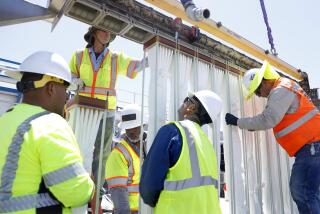Must We Throw All That Water Away?
- Share via
There is a story--which might even be true--that shortly after Sir Thomas Crapper invented the modern-type flush toilet in the mid-1800s, it was demonstrated to the then-Prince of Wales who, in common with much of the aristocracy of those days, was a very outspoken individual.
He is supposed to have said (bowdlerized a bit for a family newspaper): “All those gallons of water thrown away to get rid of half a cup of (urine)!”
toilets have been invented. One of the most effective is an ultra-low-flush appliance called the Ifo Cascade, manufactured in the United States by Colton-Wartsila Inc., headquartered in Colton.
That toilet was developed in Europe more than 10 years ago and Maurice Meyers, president of the company that began its full-scale U.S. production last year, said about 3.3 million are in use worldwide.
He said the Ifo Cascade uses one gallon of water per flush, compared to the 5.25 gallons per flush that is the national average, and therefore saves about 80% of the water used for flushing. Since toilet flushing accounts for 40% of all water used inside the house, he continued, the Ifo Cascade has the potential of saving about one-third of the water used by the typical household. Furthermore, the smaller amount of water used takes considerable of the load off sewer systems and septic tanks.
Saying that the price of water will double or triple in many communities across America in the next few years, Meyers added: “Although ultra-low-flush toilets are priced somewhat above conventional units, the premium should be justified in more and more installations every year as water and sewer rates increase.”
He described a pilot project at John Long Homes in Phoenix, where use of the ultra-low-flush toilet along with limited-flow shower heads and faucets contributed to a 76% reduction in daily water use per person.
The Prince may have been a man who was ahead of his times.
Energy conservation is also being taken seriously by the Southern California Gas Co., which is putting its money on the line to continue promoting it.
The company offers rebates to both owners of their own homes or of rental property and to renters who make certain energy-saving home improvements. The rebates can total as much as $456 for a single-family home or $250 per unit in a multifamily structure.
The program is in two parts, cash rebates and low-interest loans, and will continue through 1986. Mike Neiggemann, gas company vice president, said, “In many cases, the rebates alone may pay most or all of the costs for installing conservation measures.” In addition, he pointed out, some customers may qualify for tax credits.
The six conservation measures that qualify for cash rebates are water heater blankets, weatherstripping, caulking, low-flow shower heads, air duct insulation and attic insulation. To qualify, attic insulation (where appropriate) and at least two other measures must be installed.
Four other measures qualify for cash rebates if recommended by a home energy survey: floor insulation, night setback thermostats, pipe insulation and electric ignition for gas forced-air furnaces.
Loans at 8% interest are available for those who prefer them to cash rebates. Full details are available from the gas company’s Conservation Hotline toll-free number: 1-800-352-4124 or by picking up the free brochure “How to Qualify” at any gas company payment office.
More to Read
Inside the business of entertainment
The Wide Shot brings you news, analysis and insights on everything from streaming wars to production — and what it all means for the future.
You may occasionally receive promotional content from the Los Angeles Times.










